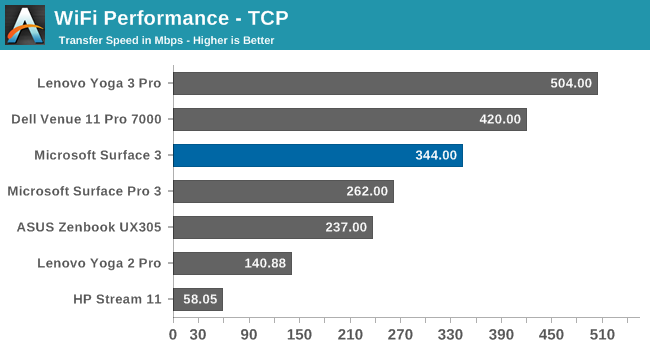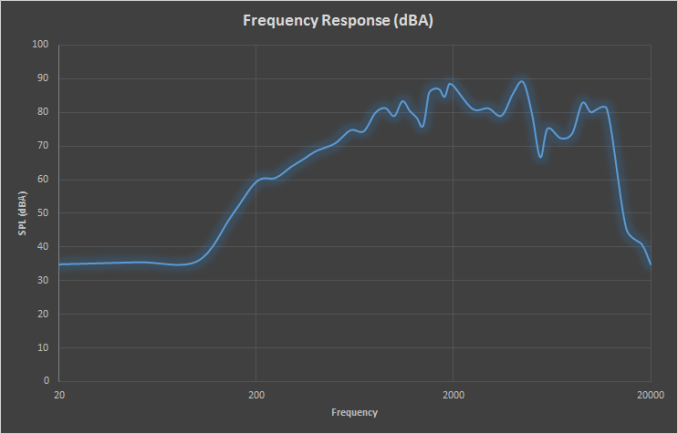The Surface 3 Review
by Brett Howse on May 4, 2015 9:00 AM ESTWi-Fi Performance
For networking, the Surface 3 features the same Marvell AVASTAR 802.11ac network adapter as its big brother. I have seen a lot of the firmware updates for Surface Pro 3 over the last year being network related, so hopefully they have all of the bugs out of it by now. During my time with the Surface 3, I did not have any issues with it. It is a standard 2x2:2 setup, and the top of the Surface 3 has a plastic section to act as a RF window.

The average speed during our TCP test was just about 350 Mbps, which is not too bad but well off of the Broadcom devices, which can see over 500 Mbps.
Speakers
The Surface 3 features to forward facing speakers hidden in the display bezel. It makes for a nice look, and having the speakers facing you helps a lot with stereo and should help with the overall sound quality too.
The Surface 3 is not especially loud, and the frequency response is about what you would expect for a small device with no room for proper speakers. There is almost no sound below 150 Hz, and around 15 kHz the sound drops away. Maximum volume I observed while playing music was 76 dB(A).
Camera
This tablet has two cameras, with the rear camera being an auto-focus 8 MP unit, and the front facing camera is actually a decent camera as well, with 2304 x 1536 resolution shots. The one quirk with the front facing camera though is that it really works best when the kickstand is in the first position, and because this is not a laptop with an adjustable hinge, you will always be limited to where it points.
The rear camera though is surprisingly good, even in low light. I am still not a fan of using a tablet to take pictures, but if you have to, this one will please you.
It will work in a pinch, but I will stick to my smartphone when I can.












265 Comments
View All Comments
RafaelHerschel - Tuesday, May 5, 2015 - link
That is a weird statement. Whose fault is it then? You're right about one thing though, AMD is woefully behind Intel. I wish it wasn't so, but I don't see AMD making any real progress soon.At this point efficiency is king and Intel with their 'mobile first' philosophy is now becoming a viable alternative for the mobile market. Sadly I don't think that AMD has the budget to compete.
lilmoe - Thursday, May 7, 2015 - link
If we're talking efficiency, then ARM is king IMHO. The upcoming custom ARMv8 designs should give Intel a run for their money. AMD's Zen cores were developed with mobile first in mind with supposed great single threaded performance. It'll be interesting to see how things fold out. Too bad we'll have to wait a year at least for that.I should have been more specific though. I should have said that it wasn't "entirely" AMD's fault since process nodes of other fabs haven't been up to par. It'll be interesting to see AMD's Zen at 14nm vs Intel's Skylake at 14nm.
lilmoe - Thursday, May 7, 2015 - link
Oh, forgot to say that the initial point was about GPUs. Even with a process lead, Intel still can't come up with a decent GPU, even compared with ARM SoCs.LogOver - Monday, May 4, 2015 - link
Do Mali or PowerVR GPUs support DX at all? And if so, how good the support is? Last time I checked there were big issues with PowerVR Windows drivers. I'm not sure if these GPUs has any good support for something other than OpenGL ES. I guess the missing features are the reason that these GPUs are so "efficient".dusk007 - Monday, May 4, 2015 - link
According to the specs http://www.arm.com/products/multimedia/mali-perfor...Mali T760 supports OpenGL 3.1 and DirectX 11. Since Dx12 does not need different hardware that should be in the cards too. They all run the Windows mobile version so drivers are available. And features are all there. Intel is just not doing a very good job.
Considering the money and resources Intel has they really should do better.
LogOver - Monday, May 4, 2015 - link
According to the specs PowerVR GPUs also supports DX since series 5. They claimed DX 10.1 compatibility for sgx 545. I had netbook with Atom N2600 and it was the worst experience I ever had with laptops because of broken windows GPU drivers and non existing Linux drivers. I doubt that the situation with Mali or Adreno is any better. In fact, Intel does have new atoms with PowerVR GPUs (z35xx) but haven't hear about any planned windows device which are using these atoms. The reason is known...BlueBomberTurbo - Monday, May 4, 2015 - link
Check the GPU charts again. The HP Stream 7 is Gen 7, and gets absolutely blown out of the water on the GPU tests against the Surface 3.dusk007 - Tuesday, May 5, 2015 - link
Sure but I mean clock for clock, eu for eu.It is 16 eu against formerly 4. Of course it is faster but that is a lot of die space even on 14nm.
Where are differences like Kepler vs. Maxwell or AMD 290X vs the last GCN. Those just get more speed out of each execution unit. The faster Broadwell also only increase execution units but there should be plenty of other improvements possible before they catch up to the competition's efficiency. A lot of the Mali "tricks" can even be easily licensed.
Speedfriend - Tuesday, May 5, 2015 - link
"One would wish Intel would just license the Mali GPUs or PowerVR designs"They already use both of them in other chips. What Intel should do is buy Imagination, they would get the PowerVR IP which would improve Atom GPUs, it would give them leverage over Apple (who I guess are still some way off having their own GPU design) and they would get MIPS which they could develop as their ARM killer in the smartphone space.
watzupken - Monday, May 4, 2015 - link
I think Cherry Trail will be great in a low power PC for surfing net and some HTPC duties. Anyway, I am not sure if the poor battery life is a result of the SOC or Windows as well. I believe Windows is not exactly a very power friendly OS in the first place if you are using it all the time.